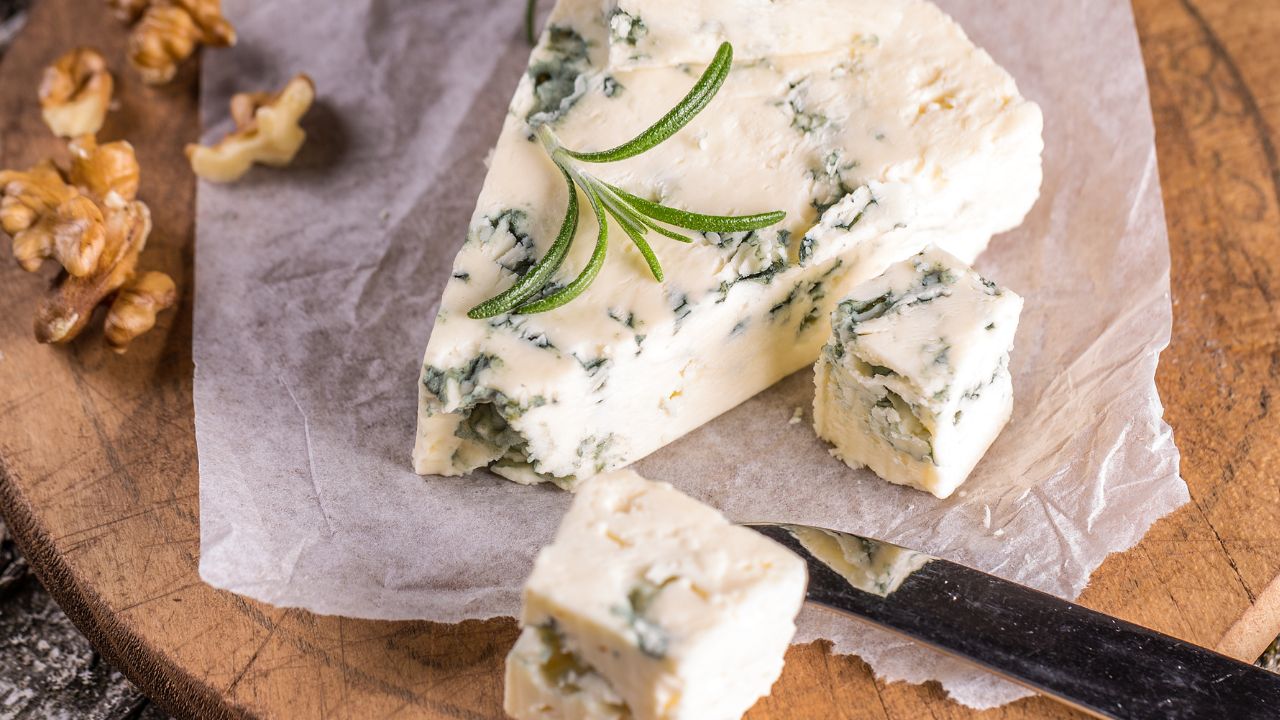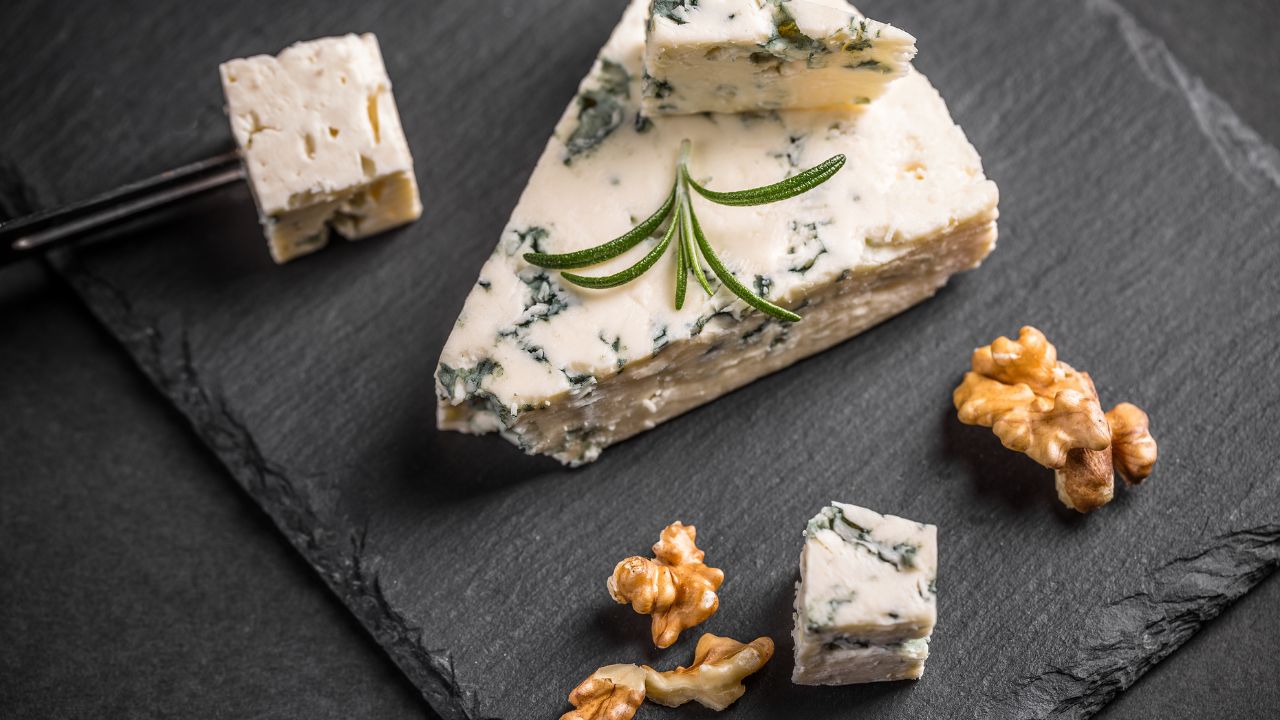With certain health benefits and a worthwhile creamy texture, Gorgonzola cheese can be quite sought after.
This is a soft, almost gooey, blue-veined Italian cheese that comes with a delicious creamy texture that is well worth trying.
However, like many blue-veined kinds of cheese, it can prove to be a divisive appearance that can put off many before they even try it.
It is worth trying to find out what Gorgonzola cheese actually tastes like before you go out and buy a pack to try to eat or cook with.
In this guide, we will try to describe the taste of Gorgonzola cheese and explain the appeal of this blue-veined cheese. We will also look at how to cook with Gorgonzola cheese.

The Taste Of Gorgonzola Cheese
You should smell a piece of Gorgonzola cheese before seeing it as it has a somewhat nutty and milky aroma.
This is a soft blue-veined Italian cheese that can be difficult to slice as it is almost runny in consistency so it has to be carefully delivered onto a plate.
That creamy texture comes with an almost sweet flavor and a moreish, buttery taste. However, the taste can differ depending on how long the cheese has been aged for.
With a reduced aging period, the Dolce version of Gorgonzola has a comparatively milder and gentler flavor than its Piccante counterpart.
The difference in the aging process may only be a month but it does impart a stronger flavor. That means that the Piccante version of Gorgonzola should taste stronger and even more rustic.
The Appeal Of Gorgonzola Cheese
As far as blue cheese goes, Gorgonzola cheese remains hugely popular in its native Italy and across the world. This may be down to how aged it is, certainly for blue-veined cheese.
It may also be down to how dated the cheese is as it originated in the town of Gorgonzola, Milan in the 11th century.
More importantly, the appeal of Gorgonzola cheese may simply be down to how versatile it is as it can be used in several different dishes.
Few types of cheese come close to the distinctive taste of Gorgonzola cheese. As the cheese is named after a town in Italy and is so well revered, its unique nature has been rewarded.
The cheese has earned the treasured status of EU’s protected designation of origin and has enjoyed it since 1996.
Gorgonzola cheese actually consists of two different varieties. These are Piccante, which is also known as Mountain Gorgonzola, and Dolce, known as Sweet Gorgonzola.
The combination of the two different varieties of cheese creates a formidable flavor profile for what is known as Gorgonzola as Dolce is known to be milder and sweeter than Piccante.
Both versions of the cheese are different, but they both use cow’s milk and are aged differently. There is not a huge difference in the aging process as there is typically only a month’s variation.
The Piccante variety of Gorgonzola is aged for at least three months. While that may not seem like a long period of time, the Dolce variety of Gorgonzola is only aged for two months and there is a variation in the flavor.
There is also a difference in the mold between the two varieties of Gorgonzola cheese. Piccante Gorgonzola uses Penicillium Glaucum.
However, the version of Dolce Gorgonzola uses plain old Glaucum mold.
How To Cook With Gorgonzola Cheese

You can cook with both varieties of Gorgonzola cheese though it is not as versatile as many other varieties of cheese.
Having said that, Gorgonzola cheese does work really well as a steak topping for a gooey texture on some juicy meat. The blue-veined cheese can also be used in a sauce alongside some sweet wine like port.
If you are intending to use the cheese in some traditional Italian recipes then drop some into a risotto as you mix it.
Further traditional Italian recipes for Gorgonzola cheese include using it with pasta. Either sprinkled liberally over a bowl of cooked pasta or cooked with it as part of a sauce.
If you think that the taste of Gorgonzola cheese is somewhat overpowering then you can mix it in with some milder cheeses.
Dollops of the cheese can also be used as a pizza topping alongside mozzarella cheese.
You may not even need to cook Gorgonzola cheese as you can simply add lumps of the soft blue-veined cheese to a salad. The taste of Gorgonzola cheese also works well with dried figs, especially the Dolce version.
If you are preparing a cheeseboard, ensure that you involve Gorgonzola cheese for the distinctive blue variety.
Final Thoughts
For those occasions when you are forming a cheeseboard and you need a soft, blue-veined cheese then you have the choice of two varieties of Gorgonzola.
Both are soft and creamy though Dolce is perhaps sweeter than Piccante which is aged for longer for a month longer. With the blue and white marbling throughout, the cheese works well on cheeseboards with grapes, honey, and pistachio nuts.
The creamy taste also works remarkably well in pasta dishes, with risotto, and on pizzas.
It may come as a surprise that Gorgonzola remains so popular yet it originates from Italy as far back as the 11th century. The cheese is made from pasteurized cow’s milk and has an appealing appearance with blue veins running throughout.
Part of that appeal comes from the aging process, but also the mold that is used in the fermentation process which is called Penicillium Glaucum.
While it may seem strange, Gorgonzola cheese is actually the union of milk and starter mold which develops the creamy texture and the nutty, slightly milky smell.
Frequently Asked Questions
What Is The Nutritional Value Of A Piece Of Gorgonzola Cheese?
For a quarter-cup of Gorgonzola cheese, you can expect a total of 100 calories. There should be around eight grams of fat, with six grams of that being considered saturated fat.
In that quarter-cup, there will be around 380mg of sodium, a single gram of carbohydrates, and six grams of protein. You can also expect to find some essential nutrients such as vitamins A, B1, B2, calcium, iron, phosphorus, and potassium.
What Are The Health Benefits Of Gorgonzola Cheese?
While many would believe that Gorgonzola cheese should be considered as somewhat unhealthy, it does come with some health benefits. These include the prevention of artery inflammation and the lowering of cholesterol levels.
Though like any food, Gorgonzola cheese should be eaten in moderation, it can help to enhance an individual’s memory and reduce the risk of contracting various heart-related issues.
- 15 Traditional Greek Breads - July 31, 2023
- 30 Delicious And Gluten-Free Cookie Recipes - July 29, 2023
- 30 Of The Best European Desserts - July 29, 2023
